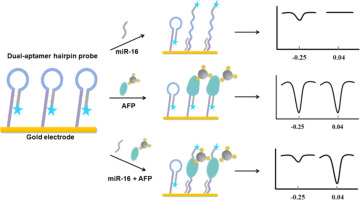Talanta ( IF 6.1 ) Pub Date : 2017-09-05 , DOI: 10.1016/j.talanta.2017.09.011 Tao Gao , Jun Zhi , Chaoli Mu , Shiyu Gu , Jing Xiao , Jie Yang , Zhaoxia Wang , Yang Xiang

|
At present, the accuracy of clinical hepatocellular carcinoma (HCC) diagnosis needs to be further improved. In this work, two kinds of serological biomarker species, microRNA and protein biomarker, have been detected simultaneously to identify HCC. Herein, a dual-aptamer hairpin DNA oligonucleotide is designed as the electrochemical sensing probe (ESP) to achieve this goal. The hairpin-structured DNA probe consists microRNA-16 (miR-16) complementary sequence and alpha fetoprotein (AFP) aptamer sequence, so it can both capture miR-16 and AFP. Once it hybridizes with miR-16, the hairpin structure is unlocked so that the terminal modified signal molecule (methylene blue, MB) would give a decreased electrochemical signal. Meanwhile, once it recognizes AFP, concanavalin A (ConA) modified silver nanoparticles (AgNPs) can bind to AFP at the sensing surface. An obvious electrochemical signal of AgNPs can thus be generated for AFP detection. In this way, one-step and simultaneous detection of miRNA-16 and AFP can easily be realized by collecting the two sensitive and non-interfering electrochemical signals. Compared with traditional single biomarker detection methods, this assay strategy can improve the accuracy of HCC by monitoring two kinds of serological biomarkers species. Besides, this novel electrochemical biosensor based on ESP is simple, low-cost and efficient, which make it promising to improve the accuracy and specificity for the diagnosis HCC in the future.
中文翻译:

一步检测两种血清学生物标志物种类,以提高肝细胞癌的诊断准确性
目前,临床肝细胞癌(HCC)的诊断准确性有待进一步提高。在这项工作中,同时检测到两种血清学生物标记物物种,microRNA和蛋白质生物标记物,以鉴定HCC。在此,将双适体发夹DNA寡核苷酸设计为电化学传感探针(ESP)以实现该目的。发夹结构的DNA探针由microRNA-16(miR-16)互补序列和甲胎蛋白(AFP)适体序列组成,因此可以同时捕获miR-16和AFP。一旦与miR-16杂交,发夹结构便会解锁,从而使末端修饰的信号分子(亚甲基蓝,MB)产生的电化学信号降低。同时,一旦识别出法新社,刀豆球蛋白A(ConA)修饰的银纳米颗粒(AgNPs)可以在传感表面与AFP结合。因此可以产生明显的AgNPs电化学信号用于AFP检测。这样,通过收集两个敏感且无干扰的电化学信号,可以轻松实现miRNA-16和AFP的一步检测和同时检测。与传统的单一生物标志物检测方法相比,该检测策略可通过监测两种血清学生物标志物种类来提高HCC的准确性。此外,这种新型的基于ESP的电化学生物传感器简单,低成本,高效,使其有望在未来提高诊断HCC的准确性和特异性。通过收集两个敏感且无干扰的电化学信号,可以轻松实现miRNA-16和AFP的一步一步同时检测。与传统的单一生物标志物检测方法相比,该检测策略可通过监测两种血清学生物标志物种类来提高HCC的准确性。此外,这种新型的基于ESP的电化学生物传感器简单,低成本,高效,使其有望在未来提高诊断HCC的准确性和特异性。通过收集两个敏感且无干扰的电化学信号,可以轻松实现miRNA-16和AFP的一步一步同时检测。与传统的单一生物标志物检测方法相比,该检测策略可通过监测两种血清学生物标志物种类来提高HCC的准确性。此外,这种新型的基于ESP的电化学生物传感器简单,低成本,高效,使其有望在未来提高诊断HCC的准确性和特异性。


























 京公网安备 11010802027423号
京公网安备 11010802027423号